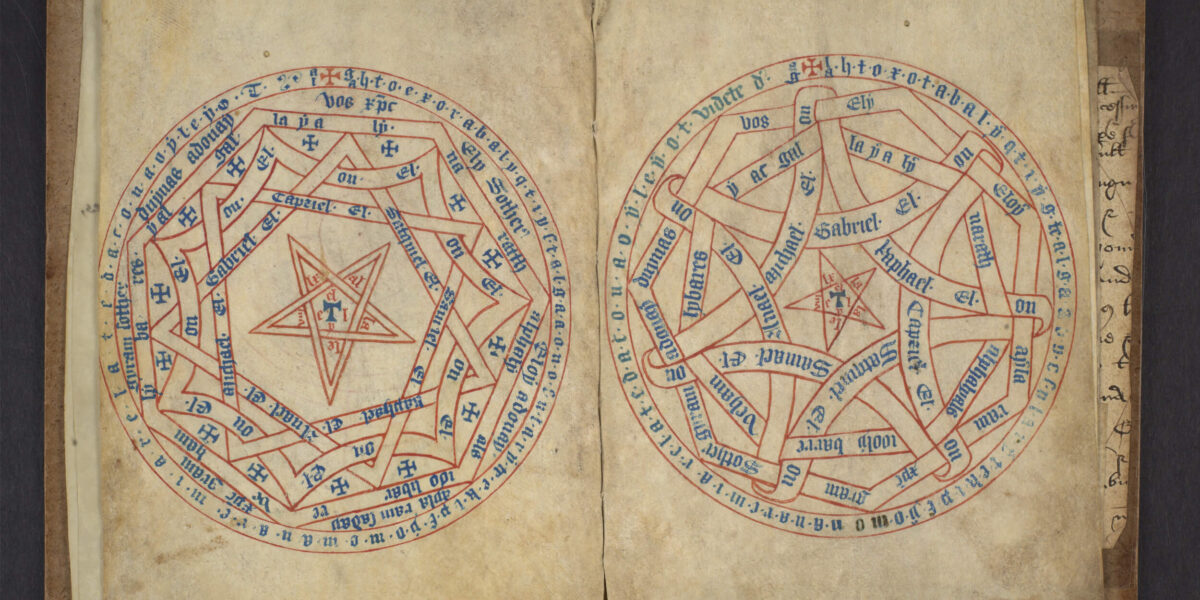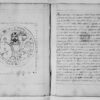Including Sigillum Dei Aemeth from Liber juratus Honorii
7 Leaves cut out of a Latin [and Spanish] manuscript, England and Spain, ca. 1410
UPenn LJS 226
Collection of astrological and astronomical diagrams gathered from 3 earlier manuscripts. After a later parchment bifolium (f. 1-2, with inscription dated 1861 and 18th- or 19th-century English title) come 3 leaves from an early 15th-century English manuscript, perhaps the manuscript book dated 1410 referred to in the title on the later bifolium, possibly from the Liber juratus Honorii, attributed to Honorius of Thebes. These present magical diagrams that are a template for a horoscope (f. 3v), a circular zodiac calendar with no indication of year (f. 4r), and 2 diagrams related to Cabala as it was understood in Europe at the time (f. 4v-5r). An inscription describes the purchasing of the parent manuscript from Richard Chamberlain and a breakdown of the price for a manuscript of 25 gatherings, lining or ruling, binding, and materials (f. 3r). The next leaf, which is folded and comes from a different manuscript, shows a diagram of the earth surrounded by spheres of the elements with an explanation that suggests the diagram concerns the cause of tides (f. 6r) and 2 astronomical diagrams of concentric circles labeled Polus articus and Polus antarticus (f. 6v). The final leaf is from a Spanish manuscript and contains a mathematical table showing the use of Arabic numerals in the computation of large numbers (up to 22 places) for astronomical calculations, with notes using the Spanish terms cuento, millon, summa, and protocuendo (f. 7r). A plain diagram in ink of a labyrinth, drawn on the verso of a fragment of an English document on paper concerning a real estate transaction, is laid in the manuscript.
7 leaves: parchment ; 170-208 x 130 mm. bound to 187 x 145 mm. + 1 note.
Providence: Part of the manuscript (f. 3-5) produced and sold by Richard Chamberlain (inscription, f. 3r).Part of the manuscript (f. 7) formerly owned by Johannes Lethe (inscription, f. 7r).Formerly owned by Sir John Chetwode of Oakley Hall, Staffordshire (armorial bookplate, inside upper cover).Sold by Sam Fogg Ltd. (London) to Lawrence J. Schoenberg, Jul. 1997.Deposit by Lawrence J. Schoenberg and Barbara Brizdle, 2011.
Notes: Ms. codex.Title from 19th-century added title page (f. 2r).Collation: Parchment, 7; 1² 2-5¹.Script: Written in Gothic book and cursive scripts.Decoration: Diagrams in blue and red (f. 3v, 4v, 5r) or brown with red (f. 6r) or red and blue (f. 6v); checkerboard pattern in ink (f. 7v).Binding: 19th-century quarter marbled paper over cardboard.Origin: Written in England and Spain, ca. 1410 (date cited in later note, f. 2r).
Sigillum Dei Aemeth
As mentioned in the above catalog, this manuscript apparently contains pages excised from a 15th century manuscript of Liber Juratus Honorii, the contents of which contain 2 variations of the Sigillum Dei (Seal of God, or signum dei vivi, symbol of the living God, called by John Dee the Sigillum Dei Aemeth). This seal is considered to be the most sacred and powerful of talismans. It is composed of two circles, a pentagram, two heptagons, and one heptagram, and is labeled with the names of God and his angels. According to Liber Juratus Honorii (‘The Sworn Book of Honorius’) it allows the magician to have power over all creatures except Archangels, but usually only reserved for those who can achieve the blessed vision of God and his angels (beatific visionary). These renditions of the Sigillum Dei Aemeth are in all likelihood the most beautiful renditions known today.
With Permission of Kislak Center for Special Collections, Rare Books and Manuscripts University of Pennsylvania LJS 226. Subject to United States copyright law U.S. Copyright Act of 1976, 90 Stat 2541.




